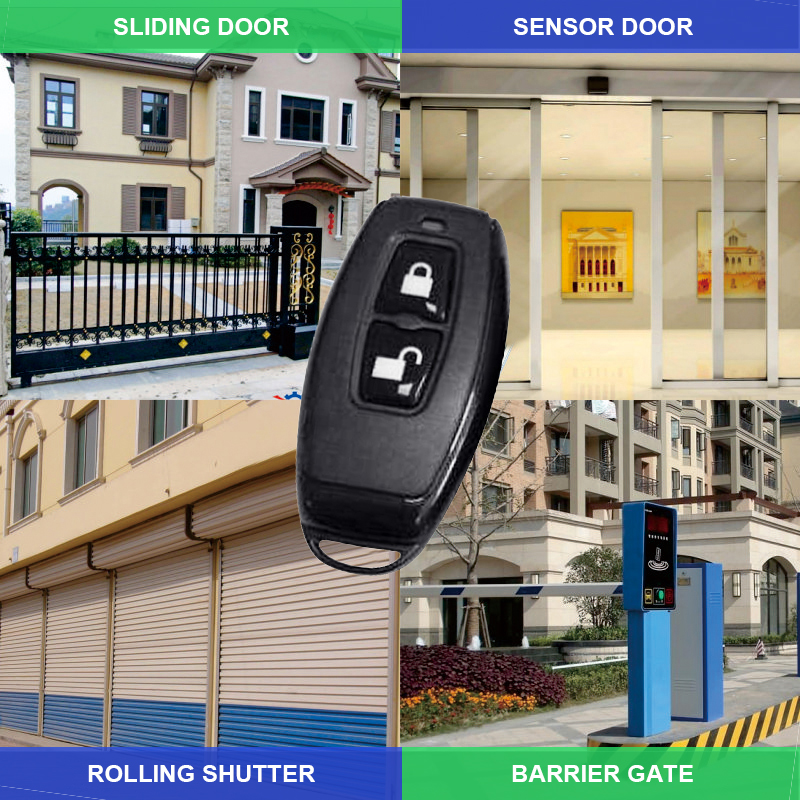Garage door remote controls are a crucial component of modern home automation systems, offering convenience and security for users. The frequency of a remote control is one of its core technologies, affecting the stability, coverage range, and interference resistance of its signal. This article delves into the frequency of garage door remote controls, including technical background, common frequencies, the impact of frequency selection on device performance, and how to address frequency-related issues.

I. Basic Concept of Garage Door Remote Control Frequencies
1. Definition of Frequency
Frequency refers to the number of oscillations of a radio wave per second, measured in Hertz (Hz). In wireless communication, frequency determines the transmission characteristics of a signal. Garage door remote controls operate within specific frequency ranges in the radio spectrum, used for sending and receiving control signals.
2. Role of Frequency
The frequency of a remote control affects its signal transmission range and penetration capability. Different frequencies have distinct propagation characteristics. For example, lower frequencies can penetrate obstacles more effectively but have a shorter transmission range, while higher frequencies offer longer transmission distances but weaker penetration. Choosing the right frequency ensures stable operation of the remote control in various environmental conditions.
II. Common Frequencies for Garage Door Remote Controls
1. 315 MHz Frequency
315 MHz is one of the commonly used frequencies for garage door remote controls. This frequency falls within the Ultra High Frequency (UHF) range, known for its ability to penetrate most obstacles like walls and buildings. This makes 315 MHz remote controls perform well in indoor and obstructed environments. Its transmission range typically spans from 30 to 50 meters, adequate for most residential garage needs.
2. 433 MHz Frequency
433 MHz is also a prevalent frequency for garage door remote controls, falling within the UHF range. Compared to 315 MHz, 433 MHz provides a longer transmission distance but has slightly weaker penetration capability. Its effective range usually extends from 50 to 100 meters, suitable for applications requiring a longer control distance. 433 MHz remote controls are widely used globally, particularly in European and Asian markets.
3. 868 MHz Frequency
868 MHz is less common in garage door remote controls compared to 315 MHz and 433 MHz but may be used in some high-end devices. This frequency, within the High Frequency (HF) range, offers good interference resistance and a longer transmission distance, typically exceeding 100 meters. It is suitable for applications requiring high reliability and extended control distances.
III. Impact of Frequency Selection on Device Performance
1. Signal Penetration Capability
Frequency directly affects the signal’s penetration ability. Lower frequency signals (like 315 MHz) can penetrate through buildings and obstacles, performing well in complex environments. However, they may have shorter transmission distances. Higher frequency signals (like 433 MHz and 868 MHz) provide longer distances but are less effective at penetrating obstacles. Selecting the appropriate frequency depends on the environment in which the remote control will be used.
2. Interference Resistance
Different frequencies have varying degrees of interference resistance. Higher frequencies (like 868 MHz) generally offer better resistance to interference and can avoid signal disruptions from other wireless devices. However, this also depends on the remote control's design and technology, such as the use of advanced coding and interference resistance features. Lower frequencies (like 315 MHz) may experience more interference but often have effective interference mitigation technologies to enhance signal stability.
3. Transmission Distance
The choice of frequency affects the effective transmission distance of the remote control. Lower frequencies (like 315 MHz) typically have shorter transmission distances but perform better in environments with many obstacles. Higher frequencies (like 433 MHz and 868 MHz) provide longer transmission ranges, suitable for scenarios requiring extended control distances. Users should choose the frequency based on the garage's size and operational needs.
IV. Frequency-Related Issues and Solutions
1. Signal Interference
Signal interference is a common issue with garage door remote controls. Interference sources may include other wireless devices, wireless networks, or even signals on adjacent frequencies. Here are some solutions to address interference issues:
Select the Appropriate Frequency: Choosing a frequency with better interference resistance (such as 868 MHz) can reduce interference problems.
Avoid Frequency Overlap: Ensure that the frequency of the garage door remote control does not overlap with other wireless devices to minimize mutual interference.
Use Interference-Resistant Design: Opt for remote controls with advanced interference resistance technologies, such as frequency hopping and encryption, to improve signal stability.
2. Weak or Unstable Signals
Weak or unstable signals in remote controls may be caused by the following factors:
Low Battery Power: Check if the remote control battery needs replacing, as low battery power can lead to weak or ineffective signals.
Obstruction: Obstacles in the signal path can affect signal strength. Try aligning the remote control with the garage door receiver or removing obstructions to improve signal strength.
Device Malfunction: If the above measures do not resolve the issue, there may be a fault with the remote control or receiver. Contact customer support for inspection and repair.
3. Improper Frequency Selection
In some cases, choosing an inappropriate frequency may lead to operational issues. Solutions include:
Understand Device Requirements: Before purchasing, understand the frequency requirements of the garage door system to ensure compatibility with the selected remote control.
Consult Professionals: For uncertainties, consult experts or technical support to get advice on frequency selection and compatibility.
V. Choosing the Right Frequency for Garage Door Remote Controls
1. Determine Requirements
When selecting a garage door remote control, first identify your needs, including signal transmission distance, interference resistance, and the environment. Choose the frequency that meets these requirements to ensure the remote control performs well in practical use.
2. Check Compatibility
Ensure that the selected remote control frequency matches the requirements of your garage door system. Different brands and models of garage doors may require different frequencies, so verifying compatibility is crucial.
3. Review User Feedback
Examine reviews and feedback from other users regarding different frequency remote controls to understand their real-world performance and issues. User feedback provides valuable practical experience and helps make an informed choice.
4. Consult Experts
If you have questions about frequency selection or remote control performance, consult experts or technical support. Expert advice can help resolve uncertainties and ensure you purchase the most suitable remote control.
Conclusion
The frequency of garage door remote controls is a significant factor affecting their performance. Selecting the appropriate frequency ensures stable operation in various environmental conditions and provides an optimal user experience. Understanding frequency basics, common frequencies, their impact on device performance, and how to address frequency-related issues helps in choosing the right remote control.
By considering frequency penetration capability, interference resistance, and transmission distance, and by understanding compatibility, user feedback, and expert advice, users can make informed decisions to ensure the best performance and experience with their garage door remote controls.

-
Office ViewQinuo Electronics Co., Ltd.was founded in 2009,it is a high-tech company that integrated R & D, manufacturing, sales and service for 15 years,which is mainly specialized in providing sensors of automatic door, control system of door and gate, car key remote, auto parts etc. The company currently has four independent brands: U-CONTROL, U-SENSORS, U-AUTOGATES and U-AUTOKEYS.
-
got questions? call us
+86 13960286508
-
fax :
+86 595 22901208 -
Email :
[email protected]
-
address
- No.991 Xingxiu Road,Taiwanese Investment Zone, Quanzhou, Fujian Province,P.R.China











